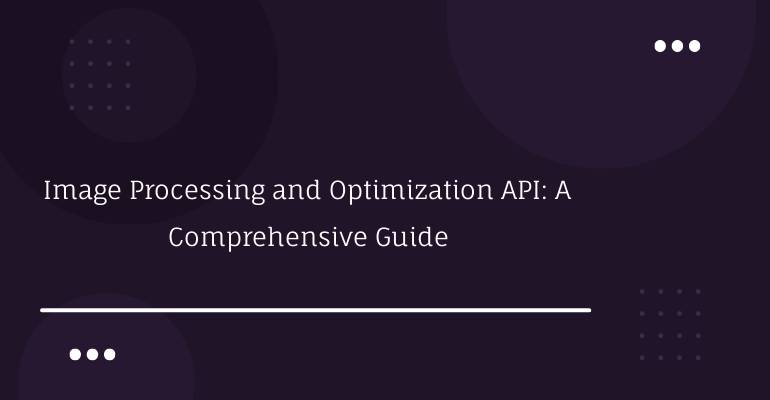Image Processing and Optimization API: A Comprehensive Guide
If you are a website owner or developer, you know the importance of optimizing your website's images to improve loading times and user experience. Image optimization is a crucial aspect of website performance, and it can have a significant impact on your search engine rankings.
In this article, we'll discuss image processing and optimization APIs that can help you improve your website's loading times and user experience. We'll cover the following topics:
- What is an image processing and optimization API?
- Why do you need an image processing and optimization API?
- How does an image processing and optimization API work?
- Features of Image Processing and Optimization API
- What are the benefits of using an image processing and optimization API?
- What are some of the best image processing and optimization APIs available?
What is an image processing and optimization API?
An image processing and optimization API is a tool that allows you to optimize images on your website automatically. These APIs use advanced algorithms to compress and resize images, which reduces their file size without compromising image quality. They can also convert images to different file formats and perform other image processing tasks.
Why do you need an image processing and optimization API?
There are several reasons why you need an image processing and optimization API:
- Faster loading times: Large images can slow down your website's loading times, which can negatively impact user experience and search engine rankings.
- Better user experience: Optimized images improve user experience by reducing loading times and making your website more responsive.
- Improved SEO: Faster loading times and improved user experience can improve your website's search engine rankings.
How does an image processing and optimization API work?
An image processing and optimization API works by using algorithms to compress and resize images automatically. These algorithms use various techniques to reduce the file size of images without compromising image quality, such as:
- Lossy compression: This technique reduces file size by removing some image data. The quality of the image is reduced, but it's usually not noticeable to the human eye.
- Lossless compression: This technique reduces file size without removing any image data. The quality of the image remains the same, but the file size is reduced.
- Resizing: This technique reduces the dimensions of the image without changing its file size. This can be useful for images that are too large for their intended use.
Features of Image Processing and Optimization API
An Image Processing and Optimization API can offer various features, including:
-
Image Resizing: Resizing images can help you reduce their size and improve their performance. APIs can resize images based on the device, platform, or screen size.
-
Image Compression: Image compression reduces the file size of images without compromising their quality. APIs can compress images to reduce their size and improve page load time.
-
Image Cropping: Cropping images can help you focus on a specific part of the image and remove any unnecessary elements. APIs can crop images automatically based on predefined criteria.
-
Image Format Conversion: APIs can convert images from one format to another, such as from JPEG to PNG or vice versa. This can help improve the performance of images on different platforms.
-
Image Optimization: Image optimization includes various techniques that can help improve the performance of images. APIs can optimize images by reducing their size, improving their quality, and more.
What are the benefits of using an image processing and optimization API?
Using an image processing and optimization API has several benefits:
- Faster loading times: Optimized images load faster, which improves user experience and search engine rankings.
- Better user experience: Faster loading times and improved responsiveness improve user experience, which can lead to increased engagement and conversions.
- Improved SEO: Faster loading times and better user experience can improve your website's search engine rankings, which can lead to increased traffic and revenue.
What are some of the best image processing and optimization APIs available?
There are several image processing and optimization APIs available, each with its unique features and benefits. Here are some of the best image processing and optimization APIs available:
- Picnie: Picnie is a cloud-based image management platform that offers image processing and optimization APIs. It can automatically optimize images for web and mobile devices and provide features such as image compression, resize images, image generation, and image Merging through REST APIs.
- Kraken.io: Kraken.io is a cloud-based image processing and optimization API that offers lossy and lossless compression, resizing, and format conversion. It also provides an API for developers to integrate image processing and optimization into their applications.
- Imgix: Imgix is a real-time image processing and optimization API that offers resizing, cropping, and format conversion. It also provides features such as color correction, face detection, and watermarking.
Conclusion
In conclusion, image processing and optimization APIs can help you improve your website's overall performance and boost your Organic Results.






